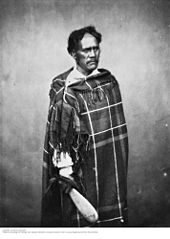Rangatira

InMāori culture,rangatira(Māori pronunciation:[ɾaŋatiɾa]) aretribal chiefs,theleaders(oftenhereditary[1]) of ahapū(subtribe or clan). Ideally,rangatirawere people of great practical wisdom who held authority (mana) on behalf of the tribe and maintained boundaries between a tribe's land (Māori:rohe) and that of other tribes. Changes to land-ownership laws in the 19th century, particularly the individualisation ofland title,undermined the power of rangatira, as did the widespread loss of land under the Euro-settler-oriented government of theColony of New Zealandfrom 1841 onwards. The concepts ofrangatiraandrangatiratanga(chieftainship), however, remain strong, and a return torangatiratangaand the uplifting ofMāoriby therangatiratangasystem has been widely advocated for since theMāori renaissancebeganc. 1970.Moana Jackson,Ranginui WalkerandTipene O'Reganfigure among the most notable of these advocates.[2][need quotation to verify]
The concept of arangatirais central torangatiratanga—a Māori system ofgovernance,self-determinationandsovereignty.[3]
Etymology
[edit]The wordrangatirameans "chief (male or female), wellborn, noble" and derives from Proto-Central Eastern Polynesian *langatila( "chief of secondary status" ).[4]Cognatewords are found inMoriori,Tahitian(i.e. theraʻatirain the nameTāvini Huiraʻatira),Cook Islands Māori,Tuamotuan,MarquesanandHawaiian.[citation needed]
Interpretations
[edit]
Three interpretations of rangatira consider it as a compound of the Māori words "ranga" and "tira". In the first case, "ranga" is devised as asandbarand the "tira" a shark fin. The allegoric sandbar helps reduce erosion of the dune (or people). The fin reflects both the appearance of the sandbar, and, more importantly, "its physical and intentional dominance as guardian".[5](p195)Rangatira reinforce communities, cease to exist without them ( "for what is a sandbar without sand?" ), and have a protective capacity.[5](p195)
Ethnographer John White (1826-1891) gave a different viewpoint in one of his lectures on Māori customs.[6]He said Māori had traditionally formed two kahui who came together to discuss history orwhakapapa.
- "Each chief in the kahui had his place assigned to him, according to the amount of knowledge he possessed; and this place was given to him by the leader of the kahui of which he was a member. This act of the leader was calledranga,or putting in order. The people, as they came to the temple in a body, were calledtira,or company; and as the leader had to assign, or ranga, a place to each of his tira, he was called the rangatira, from which we derive our word in Maori for chief, rangatira. "[6]
This interpretation fits well with a second translation where "ranga" is an abbreviation ofrāranga(or weaving) and "tira" signifies a group.[5](p195)
A third interpretation fits equally well with this translation, interlinking concepts related to the identity of the ‘tira’. In the first instance, the conditional hospitality[7][8][9]presented in the form of weaving created for the ‘tira’ of guests. In the second instance, the collective intentionality[10][11]"enacted in the weaving" of the ‘tira’ of hosts.[5](p196)Together, these concepts highlight the value attached to the "personal relationship" between the leader and their group.[5](p196)This type of relationship is similar to themahara atawhai(endearment or "benevolent concern" ) offered in theTreaty of Waitangi’s preamble byQueen Victoria,reflecting the pre-nineteenth century "personal bond between the ruler and subject".[12](p177)
References
[edit]- ^Fagan, Brian M.(26 November 1997) [1984]. "The Maori".Clash of Cultures(2 ed.). Lanham, Maryland: AltaMira Press. p. 273.ISBN9781461666790.Archivedfrom the original on 4 June 2024.Retrieved4 June2024.
The free people of Maori society were therangatira,almost a hereditary aristocracy.
- ^Smith, Cherryl; Tinirau, Rāwiri; Rattray-Te Mana, Helena; Moewaka Barnes, Helen; Cormack, Donna; Fitzgerald, Eljon (2021)."Rangatiratanga: Narratives of Racism, Resistance, and Well-being"(PDF).Te Atawhai o Te Ao, Independent Māori Institute for Environment & Health.Archived(PDF)from the original on 17 January 2023.Retrieved12 November2022.
- ^Smith, Cherryl; Tinirau, Rāwiri; Rattray-Te Mana, Helena; Moewaka Barnes, Helen; Cormack, Donna; Fitzgerald, Eljon (2021)."Rangatiratanga: Narratives of Racism, Resistance, and Well-being"(PDF).Te Atawhai o Te Ao, Independent Māori Institute for Environment & Health.Archived(PDF)from the original on 17 January 2023.Retrieved12 November2022.
Rangatiratanga is a term that encapsulates the political struggle fought by Māori to uphold sovereignty and self-determination as whānau, hapū, iwi, and as a nation. It is commonly understood as the rights that Māori 'should' have received underTe Tiriti o Waitangi.
- ^Adams, T.; Benton, R.; Frame, A.; Meredith, P.; Benton, N.; Karena, T. (2003)."Te matapunenga: A compendium of references to concepts of Maori customary law"(PDF).The University of Waikato.p. 15. Archived fromthe original(PDF)on 26 March 2012.Retrieved25 June2011.
- ^abcdeGray-Sharp, K (2011), "Ō rātou kāinga: Tino rangatiratanga and contemporary housing policy", in Tawhai, V MH; Gray-Sharp, K (eds.),Always speaking: The Treaty of Waitangi and public policy,Wellington, New Zealand: Huia, pp. 191–212,ISBN9781869694814
- ^abWhite, J. (1826–1891). An epitome of official documents relative to Native affairs and land purchases in the North Island of New Zealand.Lectures on Maori Customs, &c., by Mr. John White,Part 11.NZETC, retrieved 13 November 2001.
- ^Derrida, J. (2000).Of hospitality(R. Bowlby, Trans.). Stanford, CA: Stanford University Press.
- ^Bell, A. (2010). "Being 'at home' in the nation: Hospitality and sovereignty in talk about immigration".Ethnicities.10(2): 236–256.doi:10.1177/1468796810361653.S2CID145583138.
- ^Westmoreland, M. W. (2008)."Interruptions: Derrida and hospitality"(PDF).Kritike.2(1): 1–10.doi:10.3860/krit.v2i1.566.Archived(PDF)from the original on 23 July 2011.Retrieved18 September2010.
- ^Searle. J. R. (1990). Collective intentions and actions. In P. R. Cohen, J. Morgan, &M. E. Pollack(Eds.),Intentions in communication(pp. 401–416). Cambridge, MA: MIT Press.
- ^Tuomela, R. (2003). "Collective acceptance, social institutions, and social reality".American Journal of Economics and Sociology.62(1): 123–165.doi:10.1111/1536-7150.t01-1-00005.
- ^McHugh, P. G. (1991). The lawyer’s concept of sovereignty, the Treaty of Waitangi, and a legal history for New Zealand. In W. Renwick (Ed.),Sovereignty & indigenous rights: The Treaty of Waitangi in international contexts(pp. 170–189). Wellington, New Zealand: Victoria University Press.
